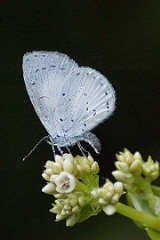
Akasinula akasa
Encyclopedia
The White Hedge Blue is a small butterfly
found in India
that belongs to the Lycaenids or Blues
family.
Female: Very similar. Upperside: the white area much more extended on both fore and hind wings. On the former it spreads well into the cell, on the latter three-fourths of the wing are white; the dusky basal and costal areas much more restricted than in the male. The iridescent blue suffusion is in many specimens entirely absent, in a few very faintly indicated ; the subterminal series of black dots so distinct in the male are generally faint and obsolescent. Underside: as in the male but the markings less distinct. Antennae, head, thorax and abdomen as in the male.
Butterfly
A butterfly is a mainly day-flying insect of the order Lepidoptera, which includes the butterflies and moths. Like other holometabolous insects, the butterfly's life cycle consists of four parts: egg, larva, pupa and adult. Most species are diurnal. Butterflies have large, often brightly coloured...
found in India
India
India , officially the Republic of India , is a country in South Asia. It is the seventh-largest country by geographical area, the second-most populous country with over 1.2 billion people, and the most populous democracy in the world...
that belongs to the Lycaenids or Blues
Lycaenidae
The Lycaenidae are the second-largest family of butterflies, with about 6000 species worldwide, whose members are also called gossamer-winged butterflies...
family.
Description
Male Upperside, fore wing: black; a medial triangular area that extends from base outwards to the disc white, suffused at base and anteriorly with iridescent blue that spreads upwards on to the black of the costa; along the dorsum the black groundcolour is much paler, in most specimens diffuse fuscous. Hind wing: white, basal third and costal margin broadly suffused with fuscous, the fuscous at base posteriorly overlaid with iridescent blue; a subterminal series of fuscous-black dots and a distinct but very slender black anticiliary line. Underside : white very slightly tinged with bluish; markings all fuscous black, minute and very slender. Fore wing: a short disco-cellular line followed by on anteriorly, strongly curved, discal series of very short detached lines and a more or less obsolescent transverse series of subterminal dots. Hind wing: three subbasal dots in transverse order; a short line on the discocellulars; a spot below the middle of the costa with a smaller spot below it; a posterior discal irregular sinuous series of five or six minute spots and a perfectly regular subterminal series of similar spots. Cilia of both fore and hind wings white. Antennae, head, thorax and abdomen blackish, the antennae ringed with white ; beneath : the palpi, thorax and abdomen snow-white.Female: Very similar. Upperside: the white area much more extended on both fore and hind wings. On the former it spreads well into the cell, on the latter three-fourths of the wing are white; the dusky basal and costal areas much more restricted than in the male. The iridescent blue suffusion is in many specimens entirely absent, in a few very faintly indicated ; the subterminal series of black dots so distinct in the male are generally faint and obsolescent. Underside: as in the male but the markings less distinct. Antennae, head, thorax and abdomen as in the male.

